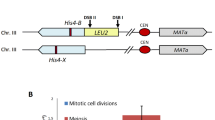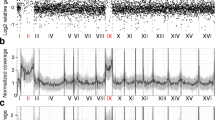Abstract
Ump1 is responsible for maturation of the catalytic core of the 26S proteasome. Dysfunction of Ump1 causes an increase in the frequency of spontaneous mutations in Saccharomyces cerevisiae. In this study we analyze the spectrum of mutations occurring spontaneously in yeast deficient in Ump1 by use of the SUP4-o system. Single base substitutions predominate among the mutations analyzed (73 of the 91 alterations examined). Two major classes are GC to TA transversions and GC to AT transitions (∼50 and ∼30% of base substitutions, respectively). Besides base substitutions, almost all the major types of sequence alterations are represented. The specificity and distribution of mutations occurring in the ump1 strain are unique compared to the spectra previously established for other yeast mutators. However, the profile of mutations arising in this strain is similar to that observed in wild type. The same similarity has previously been reported for yeast deficient in Mms2, a protein involved in Rad6-dependent postreplication DNA repair (PRR). The specificity of the mutator effect caused by ump1 is discussed in light of the proposed role of the proteasome activity in the regulation of the PRR mechanisms.


Similar content being viewed by others
References
Broomfield S, Chow BL, Xiao W (1998) MMS2, encoding a ubiquitin-conjugating-enzyme-like protein, is a member of the yeast error-free postreplication repair pathway. Proc Natl Acad Sci USA 95:5678–5683
Broomfield S, Hryciw T, Xiao W (2001) DNA postreplication repair and mutagenesis in Saccharomyces cerevisiae. Mutat Res 486:167–184
Coux O, Tanaka K, Goldberg AL (1996) Structure and functions of the 20S and 26S proteasomes. Ann Rev Biochem 65:801–847
Cariello NF, Piegorsch WW, Adams WT, Skopek TR (1994) Computer program for the analysis of mutational spectra: application to p53 mutations. Carcinogenesis 15:2281–2285
Drake JW (1991) A constant rate of spontaneous mutation in DNA-based microbes. Proc Natl Acad Sci USA 88:7160–7164
Garg P, Burgers PM (2005) Ubiquitinated proliferating cell nuclear antigen activates translesion DNA polymerases eta and Rev1. Proc Natl Acad Sci USA 102:18361–18366
Gillette TG, Huang W, Russell SJ, Reed SH, Johnston SA, Friedberg EC (2001) The 19S complex of the proteasome regulates nucleotide excision repair in yeast. Genes Dev 15:1528–1539
Giroux CN, Mis JR, Pierce MK, Kohalmi SE, Kunz BA (1988) DNA sequence analysis of spontaneous mutations in the SUP4-o gene of Saccharomyces cerevisiae. Mol Cell Biol 8:978–981
Groll ML, Ditzel J, Lowe D, Stock M, Bochtler et al (1997) Structure of 20S proteasome from yeast at 2.4 A resolution. Nature 386:463–471
Heinemayer W, Fischer M, Krimmer T, Stachon U, Wolf DH (1997) The active sites of the eukaryotic 20S proteasome and their involvement in subunit precursor processing. J Biol Chem 272:25200–25209
Hershko A, Ciechanover A (1998) The ubiquitin system. Ann Rev Biochem 67:425–479
Hoege C, Pfander B, Moldovan G-L, Pyrolowakis G, Jentsch S (2002) RAD6-dependent DNA repair is linked to modification of PCNA by ubiquitin and SUMO. Nature 419:135–141
Hofmann RM, Pickart CM (1999) Noncanonical MMS2-encoded ubiquitin-conjugating enzyme functions in assembly of novel polyubiquitin chains for DNA repair. Cell 96:645–653
Kannouche PL, Wing J, Lehmann AL (2004) Interaction of human DNA polymerase η with monoubiquitinated PCNA: a possible mechanism for the polymerase switch in response to DNA damage. Mol Cell 14:491–500
Kunz BA, Kohalmi L, Kang XL, Magnusson KA (1990) Specificity of the mutator effect caused by disruption of the RAD1 excision repair gene of Saccharomyces cerevisiae. J Bacteriol 172:3009–3014
Kunz BA, Kang X, Kohlami L (1991) The yeast rad18 mutator specifically increases G·C to T·A transversions without reducing correction of G·A or C·T mismatches to G·C pairs. Mol Cell Biol 11:218–225
Marston NJ, Richards WJ, Hughes D, Bertwistle D, Marshall CJ, Ashworth A (1999) Interaction between the product of the breast cancer susceptibility gene BRCA2 and DSS1, a protein functionally conserved from yeast to mammals. Mol Cell Biol 19:4633–4642
Matsuda T, Bebenek K, Masutani C, Hanaoka F, Kunkel TA (2000) Low fidelity DNA synthesis by human DNA polymerase-η. Nature 404:1011–1013
McDonald JP, Levine AS, Woodgate R (1997) The Saccharomyces cerevisiae RAD30 gene, a homologue of Escherichia coli dinB and umuC, is DNA damage inducible and functions in a novel error free postreplication repair mechanism. Genetics 147:1557–1568
McIntyre J, Podlaska A, Skoneczna A, Halas A, Sledziewska-Gojska E (2006) Analysis of the spontaneous mutator phenotype associated with 20S proteasome deficiency in S. cerevisiae. Mutat Res 593:153–163
Mieczkowski P, Dajewski W, Podlaska A, Skoneczna A, Ciesla Z, Sledziewska-Gojska E (2000) Expression of UMP1 is inducible by DNA damage and required for resistance of S. cerevisiae to UV light. Curr Genet 38:53–59
Moynahan ME, Pierce AJ, Jasin M (2001) BRCA2 is required for homology-directed repair of chromosomal breaks. Mol Cell 7:263–272
Ng JMY, Vermeulen W, Van der Horst GTJ, Bergink S, Sugasawa K, Vrieling H, Hoeijmakers JHJ (2003) A novel regulation mechanism of DNA repair by damage-induced and RAD23-dependent stabilization of xeroderma pigmentosum group C protein. Genes Dev 1:630–645
Pavlov YI, Nguyen D, Kunkel TA (2002) Mutator effects of overproducing DNA polymerase η (Rad30) and its catalytically inactive variant in yeast. Mutat Res 478:129–139
Pierce MK, Giroux CN, Kunz BA (1987) Development of a yeast system to assay mutational specificity. Mutat Res 182:65–74
Pillaire M-J, Betous R, Conti C, Czaplicki J, Pasero P, Bensimon A, Cazaux C, Hoffmann J-S (2007) Upregulation of error-prone DNA polymerases β and κ slows down fork progression without activating the replication checkpoint. Cell Cycle 6:471–477
Podlaska A, McIntyre J, Skoneczna A, Sledziewska-Gojska E (2003) The link between proteasome activity and postreplication DNA repair in Saccharomyces cerevisiae. Mol Micro 49:1321–1332
Prakash S, Johnson RE, Prakash L (2005) Eukaryotic translesion synthesis DNA polymerases: specificity of structure and function. Ann Rev Biochem 74:317–353
Ramos PC, Hockendorff J, Johnson ES, Varshavsky A, Dohmen RJ (1998) Ump1p is required for proper maturation of the 20S proteasome and becomes its substrate upon completion of the assembly. Cell 94:489–499
Ramsey KL, Smith JJ, Dasgupta A, Maqani N, Grant P, Auble DT (2004) The NEF4 complex regulates Rad4 levels and utilizes Snf2/Swi2-related ATPase activity for nucleotide excision repair. Mol Cell Biol 24:6362–6378
Roche H, Gietz RD, Kunz BA (1994) Specificity of rev3Δ antimutator and REV3 dependency of the mutator resulting from a defect (rad1Δ) in nucleotide excision repair. Genetics 137:637–646
Schauber C, Chen L, Tongaonkar P, Vega I, Lambertson D, Potts W, Madura K (1998) Rad23 links DNA repair to the ubiquitin/proteasome pathway. Nature 391:715–718
Skoneczna A, McIntyre J, Skoneczny M, Policinska Z, Sledziewska-Gojska E (2007) Polymerase eta is a short-lived, proteasomally degraded protein that is temporarily stabilized following UV irradiation in Saccharomyces cerevisiae. J Mol Biol 366:1074–1086
Sone T, Saeki Y, Toh-e A, Yokosawa H (2004) Sem1p is a novel subunit of the 26S proteasome from Saccharomyces cerevisiae. J Biol Chem 279:28807–28816
Stelter P, Ulrich HD (2003) Control of spontaneous and damage induced mutagenesis by SUMO and ubiquitin conjugation. Nature 425:188–191
Xiao W, Chow BL, Fontanie T, Ma L, Bacchetti S, Hryciw T, Broomfield S (1999) Genetic interactions between error-prone and error-free postreplication repair pathways in Saccharomyces cerevisiae. Mutation Res 13:1–11
Acknowledgments
We thank Dr. Bernard Kunz for providing the SUP4-o system and the experimental protocol for determination of the spectrum of mutagenesis. This work was supported by grant N303 040 31/1306 from the Polish Ministry of Education and Science.
Author information
Authors and Affiliations
Corresponding author
Additional information
Communicated by M.P. Longhese.
Rights and permissions
About this article
Cite this article
McIntyre, J., Baranowska, H., Skoneczna, A. et al. The spectrum of spontaneous mutations caused by deficiency in proteasome maturase Ump1 in Saccharomyces cerevisiae . Curr Genet 52, 221–228 (2007). https://doi.org/10.1007/s00294-007-0156-8
Received:
Revised:
Accepted:
Published:
Issue Date:
DOI: https://doi.org/10.1007/s00294-007-0156-8




